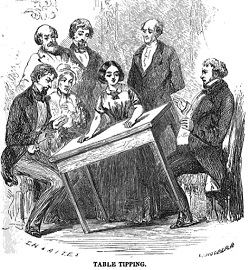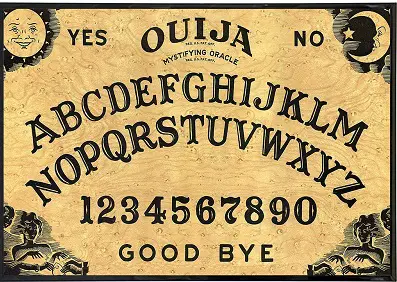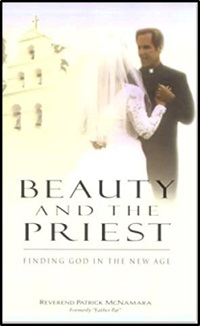TRANSLATE THIS ARTICLE
Integral World: Exploring Theories of Everything
An independent forum for a critical discussion of the integral philosophy of Ken Wilber
 David Christopher Lane David Christopher Lane, Ph.D.
Professor of Philosophy, Mt. San Antonio College Lecturer in Religious Studies, California State University, Long Beach Author of Exposing Cults: When the Skeptical Mind Confronts the Mystical (New York and London: Garland Publishers, 1994) and The Radhasoami Tradition: A Critical History of Guru Succession (New York and London: Garland Publishers, 1992). The Psychic Deception
Table-Tipping, Ouija Boards,
and Resisting Occam's Razor
David Lane
The fly in the ointment, however, was me. They were under the mistaken impression that I was a believer in all things paranormal.
Back in the Spring of 1984 I was teaching a course in Death and Dying at the University of San Diego, High School. It was a class comprised of juniors and seniors and which was then regarded as a fairly unusual subject to teach at a Roman Catholic institution. I was conversant with the subject since first reading Raymond Moody's groundbreaking Life After Life and following up with Kenneth Ring's more scientific texts, particularly Life at Death, back in the late 1970s, early 1980s.
However, like most High School classes which meet five days a week, month after month, my students could get a bit antsy, especially after lunch. I sensed that we needed to liven things up a bit (bad pun, no doubt). A few days prior, our in-house priest, Father Patrick McNamara informed me that he and a nun had been doing various experiments channeling spirits from beyond the grave. I was surprised that a priest and a nun would actually indulge in such necromancy when I knew the Church had regarded such practices as mostly demonic.
But Father McNamara was a liberal thinking priest, who was attracted to heretical ideas and practices. Later we would learn a darker side to him, but during that term we just thought he was nice and friendly, even if a little different.
Father Pat, as he liked to be called, asked if he and his nun friend (her name escapes me) could come to my Death and Dying class and demonstrate a spirit medium process called table tipping. I was already familiar with the practice and thought it would be an interesting phenomenon to witness. Moreover, I was quite sure that my students would love to see how it was performed.
It was around 1:30 when Father Pat and his nun friend showed up. Father Pat, who served as chaplain, was well-known to everyone at the school, so I took a seat in the far back of the classroom and let him introduce the topic and the necessary protocols for plugging into the spirit world.
If I remember correctly he brought in a small card table with him and set it up so everyone could see. He then let the nun speak about what they were trying to accomplish. The nun mentioned that they had been communicating with a specific spirit-entity for the past several weeks who had the ability to answer almost any question asked of it (or he/she/they?).

How did they accomplish such a remarkable feat in communicating with a disembodied spirit? They both attempted to empty their minds and be open to the spirit which they believed could come through them if they were transparent conductors. Once they were in the right mood and setting, they then placed both of their hands on the card table. At that point, they would then ask a series of questions and to the wonderment of my students the table's legs would lift up and then hit the ground. It was like a tapping sound. Each tap or series of taps represented a letter in our alphabet or if it was a yes/no type of question one tap would be “yes” and two taps “no.”
Father Pat and the nun both claimed that they were not moving the table themselves, but that the spirit was using them as conduits and the spirit itself was doing the lifting.
Many of my students were mesmerized and started asking all sorts of questions. And, apparently, the table spirit was on a roll that day because my students thought the answers to their respective queries were spot-on.
It was a fun exercise, but I was a bit flabbergasted by how gullible Father Pat and the nun were about what they thought was happening. Even my more cynical students seemed to be taken in by table tipping.
I could only take so much gobbledygook in the back of the room, so I finally asked Father Pat and the nun to remove their hands from the table and let it speak directly to us without their intervention. Surprisingly, they hadn't thought of doing that before and given their obvious credulity they both agreed it was a good idea. So, taking their hands off the card table and walking away about three feet, they started asking simple yes/no questions of the table-spirit to see how it/she/he/they would respond.
Silence.
We waited for another three minutes.
More silence.
Then, one of my more outspoken students, yelled out, “Hey, Mr. Lane, your skepticism made the spirit disappear. That sucks!”—inferring that there really was a table-spirit but my doubting such a thing he/she/it/ really existed, they got pissed and went back to the nether regions.
I couldn't help but start laughing at our group naiveté.
It was so obvious that Father Pat and the nun were moving the table and not some disincarnated spirit that has nothing better to do on Tuesday afternoons than show up to a Catholic high school on the hill in San Diego. But Father Pat and the nun didn't see through the charade and thought like my student that being hyper critical of the paranormal was the problem, not the solution to a bad parlor trick, even if performed unconsciously.

The next day one of my students asked me about Ouija boards and said she knew it worked and that it was a dangerous tool to bring in the devil. I gave a sardonic look at my class and said, “Think about this for a few seconds. Do you really believe that souls from the other side wait until you buy a Kennard Novelty Company game and open it up to play it and then they show up to bedevil the players?”
But several of my students then protested, “But, Mr. Lane, we know it works. We didn't move the pointer. It moved by itself.” At this juncture, I then said, “So you are telling me the pointer, known as the planchette, moved because of some ghost that gets called and comes down and likes to move plastic around?”
I continued, “Okay, I have an idea. Instead of having a slippery board in which to move your plastic cursor around, put Velcro down on the playing surface and put Velcro on the planchette. Do you think it is still going to move without your interference?”
My students immediately got my point and realized the real cause of how a Ouija board works.
Of course, one of my funnier surfer students then shouted, “Of course, it won't work. Spirits don't like Velcro, it is like kryptonite to them.” At which we all laughed.
Later I got the opportunity of teaching a graduate course in parapsychology at the University of Humanistic Studies in Del Mar, which eventually turned out to be a disaster. There were about 15 students in the M.A. course and they were all eager to explore psychic powers, UFOs, spoon-bending, and the like.
The fly in the ointment, however, was me. They were under the mistaken impression that I was a believer in all things paranormal. To wit, I was the complete opposite. What I wanted to accomplish in the course was a thorough examination of various parapsychological claims and see how well they held up to rational scrutiny. In other words, I wanted my students to look for alternative explanations for what others deemed miraculous. Perhaps science wasn't up for the task and maybe some events are indeed transcendent and not amenable for a more mundane explanation. But we would never know that if we didn't critically investigate the phenomena from a skeptic's or a magician's or physicist's perspective.
I knew it was not going to be an easy sell, because when we went around the room and introduced ourselves and our interests, each student had very firm convictions about angels, channeling, palmistry, astrology, and telekinesis. I distinctly remember one older woman looking me straight in the eye and saying, “I know the spirit realm is real because I am the reincarnation of the Virgin Mary.”
Eventually after going over a series of readings that were required for the class, each student was assigned a research project to investigate further and summarize their findings. The underlying key to the course, however, was that they had to look more objectively at their chosen topic.
I still vividly recall when at the end of the term, each of the students (without exception) discovered that what they had believed so full heartedly and with certainty turned out to be much less supernatural than they thought. Indeed, using the tools of Occam's Razor, Laplace's Dictum, Hume's Maxim, and common sense, each student found that the deeper they probed into the subject, the less magical it became. The reasons for this were fairly simple and rudimentary. In our rush to believe, we tend to overlook more straightforward explanations for why and how they occur. Believing something is miraculous enlivens our lives and gives us a sense of purpose and mystery. Yet, as I tried to explain to my class (as I still do today) the mystery of life and the cosmos is not lessened by rationality or logic—just as the stars are not lessened in their beauty because we use telescopes.
If anything, science broadens and enlarges our sense of mystery and wonder and awe. But more often than not, science (which properly employed) does debunk many of the myths and miracle stories we wrongly held to be inexplicable.
For some students the course was an awakening, whereas for others I could sense it was the ultimate buzz kill. “You mean, the Shroud of Turn is most likely a fraud?” “My astrological sign doesn't truly reveal my personality traits?” “Extraterrestrials haven't visited earth yet?” “Crop circles are man-made?” “Speaking in tongues is not unique to Christianity?” “My guru is a pedophile?” “Uri Geller can't bend spoons by mind power alone?” “TM meditators don't truly levitate, but merely hop on cushions?” And the list goes on.
Naturally, this doesn't mean that all my students became Carl Sagan-like skeptics, but it did open them up (and me as well) to a plethora of other possibilities that are worthy of consideration before succumbing to transcendental theorizing.
ADDENDUM
As I was writing this brief memoir about my Death and Dying class, I started to wonder what happened to Father Pat, since I left teaching high school in the Spring of 1984 when I secured a Regents Fellowship to get my Ph.D. in the Sociology of Knowledge at the University of California, San Diego. I did a little research and was not at all surprised to learn that he eventually left the priesthood in the mid-1990s. He got married and wrote a spiritual treatise entitled, Beauty and the Priest: Finding God in the New Age. In that text he explores channeling, reincarnation, and psychic surgery.
In looking over his credits, Father Pat mentioned Adele Tinning from San Diego, who was relatively famous in the early 1970s for being proficient at psychic table tipping. Seeing her name in print jarred a long-forgotten memory on my part since when I was still in high school my girlfriend's mother at the time made sure that Adele Tinning sent me an autographed book with a special message for me. We even corresponded and Adele once wrote me a long letter explaining her abilities. She seemed like a very sweet person, even though I found her psychic claims to be anything but.
John R. Baker of the AAPS (Academy for the Advancement of Postmaterialist Sciences) describes a little about Adele Tinning and her method, taking a more open-ended approach. By the way, I am fairly sure that Father Pat and the nun must have learned of table tipping directly from her. Writes Baker:
“In class, Tinning described a typical visit to her home. Sitting around the kitchen table, her guests would ask a question of the spirit world. In response, the table would tilt up on two legs and then drop down again. Counting the number of times the table rose and fell before there was a short pause yielded a letter; stringing these together produced the words of the answer (occasionally, she reported, the spirits would “misspell” a word slightly. She would then correct their spelling for the final transcription).
Tinning also told us that she dealt with more than one spirit. Sometimes, Jesus would come. According to Tinning, he could be recognized by the gentle manner in which he raised and lowered the table. More often, however, it was Moses who brought the messages from beyond. Moses was a rather rambunctious spirit, and when he was “talking,” the table would rise and fall tumultuously. Tinning, by the way, told us that neither of these spirits was anything like their Biblical characterizations. They were equals in the spirit world, but with personalities as different as those of any two of us. . . .
 Adele Tinning
Adele Tinning
Finally, after this had been going on for about 15 minutes, one of the students who was not seated around the table asked if the effect would be the same if Tinning left the table and a completely different group sat around it. Tinning replied that she had never attempted this, but that it was worth a try. Now, I too sat down at the table. Another question was posed, and the table began to rise! It rose on the side where I was sitting. I had been gently resting my hands palm down upon the table, and the sensation I had was that I was slowly lifting them off of the table, except that the table came with them. The perception of my gentle connection with the table remained as it had been while it had been standing on all four legs. The rising and falling continued some time.
While the second group was at the table, Tinning was sitting some feet distant. The room was well lit and, as with the first group, many of the observers were on their hands and knees, watching what was transpiring underneath the table. As before, no one was able to detect any use of hands, arms, or legs.
Apart from Staniford and one other person, all of the observers were either students or friends of students. The exception was a woman who had been introduced to us as a reporter from a local newspaper. She had supposedly heard of Tinning's abilities, was very skeptical of them, and wanted to find out for herself. She was, if I recall correctly, one of the persons who sat around table as part of the second group. Like Tinning before her, she was not observed to exert any pressure on the table. As far as I could tell, the look of amazement which was written on her face while the table was rising and falling was indeed genuine.
Since the room was well illuminated, and because I had personally helped select the table which we used, had been watching both above and below the table while it was tilting during the first session, and was also able to sit at the table during the second, I was forced to admit that my prior learning and experience offered no credible explanation for what I had observed. Perhaps Tinning really was communicating with the 'spirit world,' or perhaps she was tapping into something on a more mundane plane. Or perhaps she was simply a very good trickster. I have never received a satisfactory explanation for this event. Until I do, it is stored in my memory under 'Pending.'”
|
 David Christopher Lane, Ph.D.
Professor of Philosophy, Mt. San Antonio College Lecturer in Religious Studies, California State University, Long Beach Author of Exposing Cults: When the Skeptical Mind Confronts the Mystical (New York and London: Garland Publishers, 1994) and The Radhasoami Tradition: A Critical History of Guru Succession (New York and London: Garland Publishers, 1992).
David Christopher Lane, Ph.D.
Professor of Philosophy, Mt. San Antonio College Lecturer in Religious Studies, California State University, Long Beach Author of Exposing Cults: When the Skeptical Mind Confronts the Mystical (New York and London: Garland Publishers, 1994) and The Radhasoami Tradition: A Critical History of Guru Succession (New York and London: Garland Publishers, 1992).


